face to face
Why would I suggest that bible or book could be thought of as an interface? Often, we associate interface with digital technologies. Human Computer Interface (HCI) and Graphical User Interface (GUI) have become major area of study and discourse in the world of software design. Yet, the word ‘face’ has come to signify human interaction unmediated by digital technologies in the common phrase ‘face to face.’ There is a great deal of discussion these days about the different values of online/virtual/digital interaction and the so-called ‘face to face.’ For example, Sherry Turkle has become a prominent public voice in discussions of technology and its social effect, as evidenced in the impressive attention captured by her new book, Reclaiming Conversation: The Power of Talk in a Digital Age. I first encountered Turkle’s work while engaging a Richard Cohen article, ’Ethics and Cybernetics: Levinasian Reflections,’ in my struggle with the face to face language in online education. Using her work from 1995, Life on the Screen, Cohen offers Turkle as an example of media scholars who champion the advantages of cybernetics and internet communication technologies for redefining subjectivities in the direction of post-modern notions of multiplicity and instability (Cohen, ‘Ethics and Cybernetics,’ 27, n. 2).
Turkle’s more recent work (e.g. Alone Together and Reclaiming Conversation) has shifted focus from this earlier celebration of the fragmented self to a serious anxiety about the effects of robotics and mobile devices on our social capacities as humans. Two minutes into a 2015 NPR interview titled ’Making the Case For Face to Face in an Era of Digital Conversation,’ Turkle suggests that ‘face to face conversation is the most human and humanizing thing that we do, it’s where we learn to put ourselves in the place of the other.’ For many, this phrase, ‘face to face,’ as Turkle uses it has come to represent ‘real’ human interaction as opposed to a weak simulation or even cheap imitation that happens through internet media.
Part of why the language of interface compels me is because it can unsettle this binary between digital interfaces and this ‘face to face’ advocated by Turkle. Conversation over the coffee table and exchanges on Twitter can both be understood as interface and both are mediated by technologies if we understand language as a technology. So, this term, ‘interface,’ pushes beyond any digital/analog or virtual/real dichotomies and demands that we think about interface design in whatever media we find ourselves using. In a way, we could imagine ‘interface,’ the intersection of faces, as a useful translation of the phrase ‘face to face.’
If we look at the basic uses of ‘interface’ in the English language, we can see the strong indication of interaction and connection as well as the prevalent use in the computing arena.
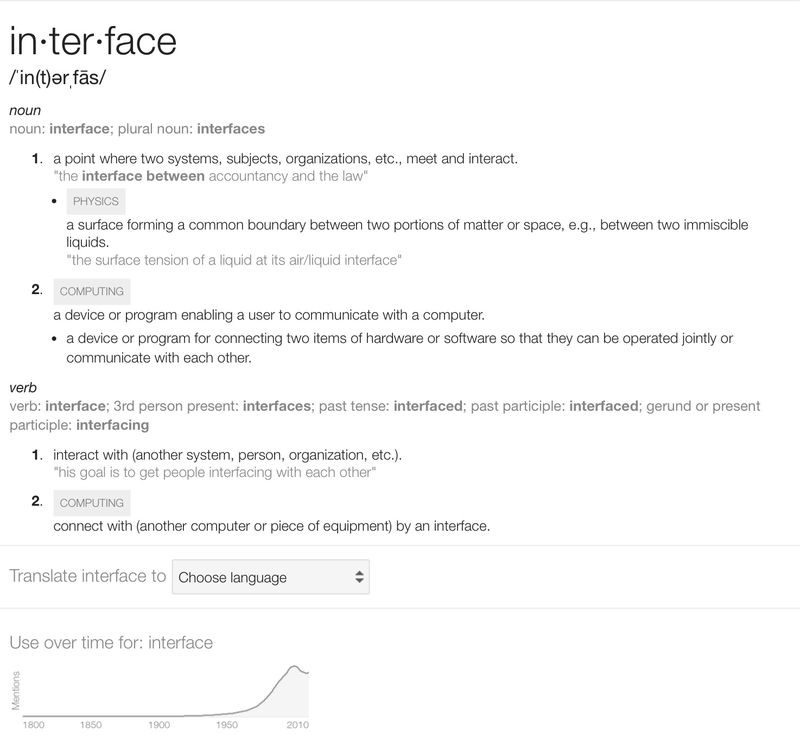 (Google Search, ’interface definition’)
(Google Search, ’interface definition’)
Here in these definitions, we can see that the ‘face to face’ championed by Turkle and others can easily fit into the notion of interface as ‘a point where two subjects meet or interact.’ When I take up the language of interface, I am not limiting our conversation to digital technologies that afford human interaction with machines. I hope to explore interface as a broader category for spaces of encounter that include many forms of media and mediation.
zone of encounter
Johanna Drucker offers an approach to interface that fits well with this idea of spaces of encounter. In her essay, ‘Humanities Approaches to Interface Theory,’ Drucker helpfully intertwines digital media studies explorations of interface design with humanities questions of subjectivity. In an exemplary fashion, Drucker demonstrates a reflexive practice by stating her desire to explore the theory undergirding her own scholarly working environments at the cusp of a transition from print to other dominant media/interfaces.
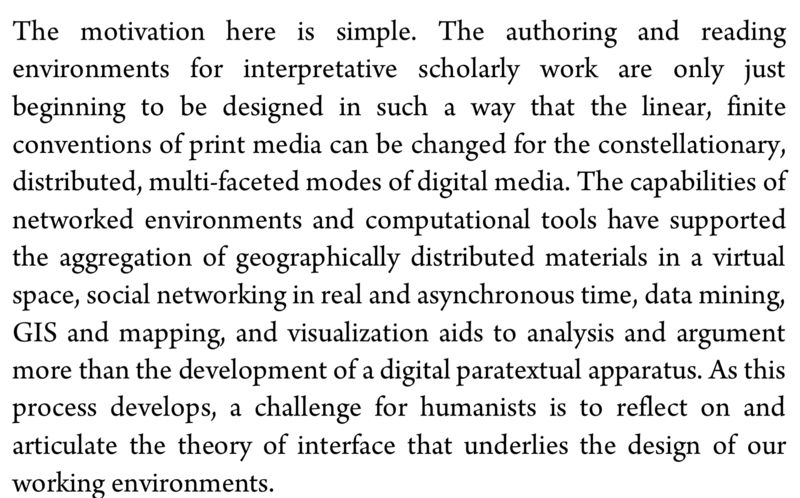 (Drucker, ’Interface Theory’, 2)
(Drucker, ’Interface Theory’, 2)
Drucker shows her awareness of the shifts at work in the emerging digital media age and asks us as humanists to become a part of the process of constructing a theory to support the design of our reading and writing spaces as a counter balance to the often mechanistic principles at work in software design (Drucker, ‘Interface Theory,’ 1-2). I see this project as contributing to these efforts and I am grateful for the challenge from Drucker and others. As she looks to GIS, social networking, and visualization for hints of new possibilities, we may even look back into print technologies (e.g. Talmudic page) for some suggestions toward interface design that might afford a bible textual apparatus that is ‘constellationary, distributed, and multi-faceted.’
Combining graphical reading analysis, frame analysis, and a constructivist model of subjectivity, Drucker gives us a view of interface as more of a theatre than a window (Drucker, ’Interface Theory’, 9).
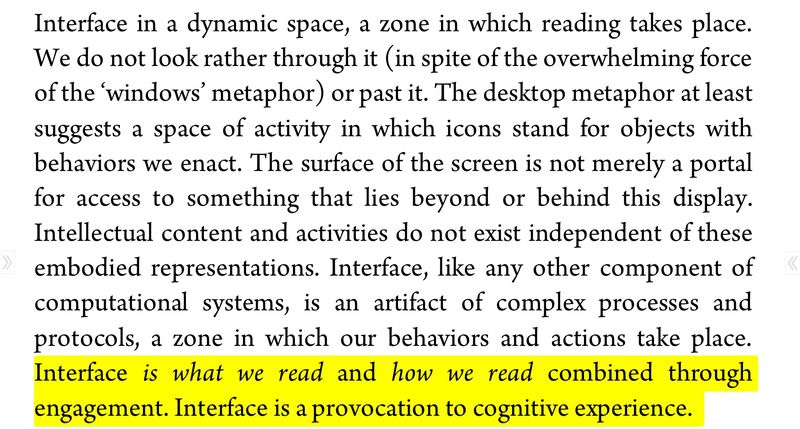 (Drucker, ‘Interface Theory,’ 9)
(Drucker, ‘Interface Theory,’ 9)
Instead of a thing, interface is a zone of encounter. So, if we turn toward books and reading more specifically, ’Interface is what we read and how we read combined through engagement’ (Drucker, ‘Interface Theory,’ 9). This is a critical point in the relationship of bible and/as media. If an interface involves both what we read and how we read, the design of the book technologies we use when reading shapes the reading performance and meaning made as much as the content. Reading bible in a codex is a different zone of encounter than reading bible on an iPhone, thus, both the book and the reader are constituted differently in these two interfaces. This means that the transitions from scroll to codex and codex to internet are not simply new ways of reading the same content. Rather, bible and reader are both transformed in the new space of encounter made possible by these different interfaces.
Another way to state the importance of interface in the reading process is to suggest that the structures of a particular book technology ARE information, not merely a means of access to information. This is another way of bothering the dichotomy between form and content or medium and message. In this interface as zone of encounter, medium and message are so inextricably entangled that attempting to tease them apart is futile. Drucker highlights this well, saying,
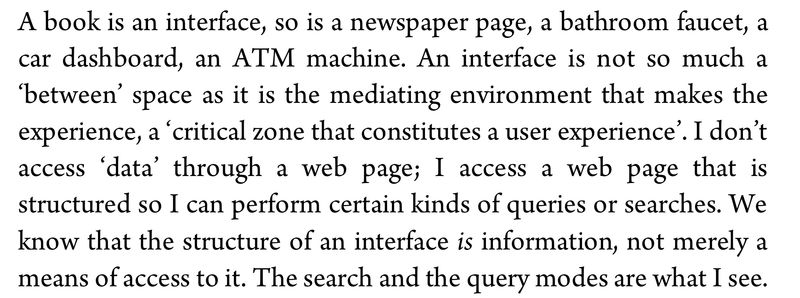 (Drucker, ‘Interface Theory,’ 10)
(Drucker, ‘Interface Theory,’ 10)
In this example, the ‘page’ (interesting that this structure of page persists into the internet ecosystem. Perhaps more evidence of the palimpsestuous nature of media translations) is not simply a window through which a user accesses data. Rather, the page is a part of the data and the data, in part, structures the page. So, with a codex, the space of the page is part of the data of the text, not simply a delivery mechanism. The shift from zone to space in Drucker’s language here, particularly a space that is something other than a space ‘between,’ surfaces a potential contact between interface and thirdspace in Edward Soja.
interface as thirdspace
Drucker is mostly focused on scholarly reading and writing practices and the role of the human subject in the construction of these spaces. If interface is a space of encounter, but something more than simply a space between, then we can imagine resonances between Drucker’s interface theory and Edward Soja’s notion of thirdspace. Interface as space can push beyond the intersection of two systems toward creating spaces that Foster emergence. As I mentioned earlier, the term ‘interface’ has the potential to challenge the binary struggle between both the virtual (digital) and real (face to face) and the what and the how of reading practice. One of the most important operations of thirdspace for Soja is to challenge any form of cultural inquiry that reduces to binaries, so Druker’s interface is already participating in a value of thirdspace. In fact, the subtitle of Soja’s Thirdspace holds together the terms of this virtual/real binary by exploring ‘real–and–imagined places.’
Soja builds off of Henri Lefebvre’s work in Production of Space to suggest an important role for spatiality in the process of cultural meaning making. Soja begins his introduction with a focus on participatory construction of space which sounds like the practice of interface in Drucker:
 (Soja, Thirdspace, 1)
(Soja, Thirdspace, 1)
This idea that we are “intrinsically spatial beings” is one example of Drucker’s suggestion of a constructivist subjectivity. For both Soja and Drucker it is not simply that we together construct space but also that spaces construct us as we construct spaces. Soja’s mention of social consequences here makes me think of Marsh McLuhan’s famous adage that the medium is the message. Though often misunderstood as reductionist or absolutist, McLuhan is simply suggesting that the message of any medium is its social effect not the content it contains (McLuhan, Understanding Media, 8). Both Soja and Drucker do us a favor to remind us that our materiality which can be called media or can be called spatiality has a significant impact on our sociality. This is precisely what I hear McLuhan saying in the medium is the message.
As we have seen, Drucker’s notion of interface already challenges binaries and encourages a more spatial and material and constructed notion of both media and the subject. So, why add thirdspace into the mix? What Soja’a thirdspace ads to our emerging theory of interface is his approach of ‘thirding as Othering,’ which practices an infinite preference for an alternative when faced with a binary choice (Soja, ’Afterword,’ 1421). This explicit and intentional methodology of surfacing multiplicity when faced with a binary may not guide interface design or theory like it does Soja’s cultural critique. Yet, what I hear in Lefebvre’s il y a toujour l’Autre and in Soja’s thirding-as-Othering is a disposition toward emergence of the chaotic kind, alternatives that challenge established categories and resist closed analysis without a need to eradicate these categories. Interface as thirdspace pushes the multiplicity Drucker encourages in her framing of interface toward a property of emergence in interface that will always overflow our analysis. Drucker says,
 Drucker resists the strictly functional and mechanistic theories of interface design and asks humanists to imagine something more variable and responsive to the particularities of the people and the spaces involved in interface. Interface as thirdspace suggests that even these combinatorial particularities do not produce the total set of possibilities, ‘there is always an-Other.’
Drucker resists the strictly functional and mechanistic theories of interface design and asks humanists to imagine something more variable and responsive to the particularities of the people and the spaces involved in interface. Interface as thirdspace suggests that even these combinatorial particularities do not produce the total set of possibilities, ‘there is always an-Other.’
interface as translation
??? – with Piotr Blumczynski’s new book Ubiquitous Translation and the focus on the WHAT and HOW, I feel like I could link the WHAT and HOW of reading in Drucker to the WHAT and HOW of translation and suggest that interface is a kind of translational event. In a sense then, we have at least two kinds of translations going on with bible, a material media translation of book from print codex to mobile phone as well as the translational act that is interface.
book as interface
So, we have moved from the mechanistic idea of interface as a thing through which we view data, to a constructivist interface as a zone of encounter that constitutes a space and a subject, finally to a spatial interface as thirdspace with a disposition toward interruptive emergence. The important strand that follows this trajectory is the continued challenge to any compartmentalization of what and how we read. Just as interface is not simply a thing we look through, a book is not just a container for content. A book is an invitation to an encounter in the practice of reading and the materiality of this encounter has as much to tell us about meaning as the stories we read.
Near the end of her exhortation to humanities scholars to take seriously the task of building a theory of interface, Drucker reminds us that book has always been an interface.
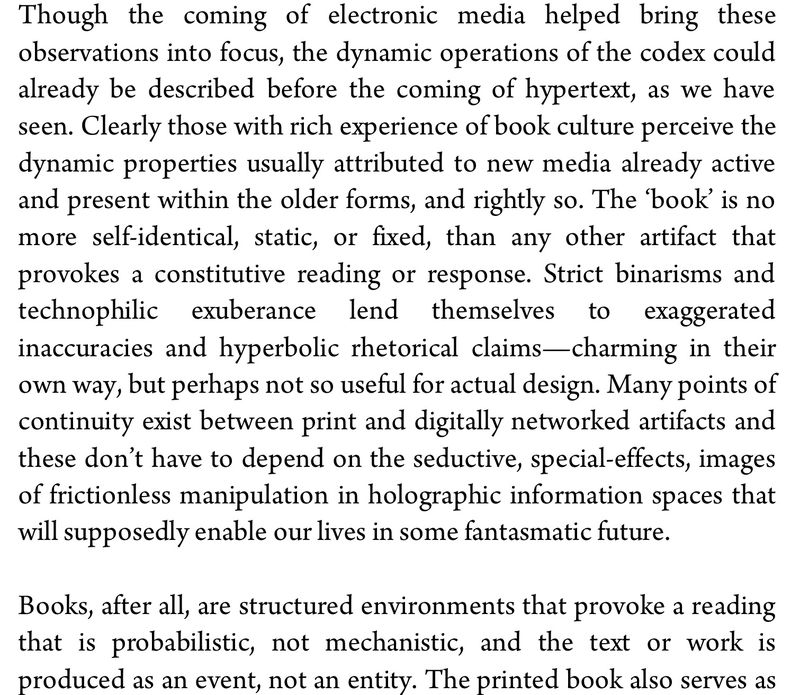 (Drucker, ‘Interface Theory,’ 18)
(Drucker, ‘Interface Theory,’ 18)
I quote Drucker here at length for two reasons. First, I have at times been prone to and accused of the charming ‘strict binarisms and technophilic exuberance’ Drucker cautions of here. Though I have found hyperbolic rhetoric useful at times to unsettle our unquestioned assumptions about media, I want to be exceedingly clear that, with Drucker, I am not interested in propagating some old/new hierarchical dichotomy between codex and emerging book technologies. This is why I began with material media translation as a palimpsest in my introduction. Each emerging book technology is a translation of what came before it, a writing over that never fully replicates and only partially erases.
Second, this passage from Drucker begins and ends with a reminder that book has always been an interface. As the materiality of this interface shifts, we will undoubtedly learn from previous forms as we explore the affordances of emerging technologies. The last full sentence of this passage captures nicely the importance of understanding book as interface. To paraphrase in alliterative fashion, Drucker suggests that a book is an interface that provokes probabilistic production through the reading event (Drucker, ‘Interface Theory,’ 18). Let’s look closely at each of these p-words in reverse order, production, probabilistic, and provokes.
production
Drucker continues to pound home her constructivist approach to both subject and text by reiterating that a text or work is produced in the encounter facilitated by the book. This is another way of stating that book is not simply a window or a container through which we access and consume a text. Rather, book is a space (is it too reductionist to correlate space and ‘a structured environment’ in Drucker?) that begs an encounter between reader and the structured environment of the interface and more. Drucker’s foregrounding of reading as production rather than simple consumption of a text reminds me of the problematization of the production/consumption binary in Michel de Certeau’s work, The Practice of Everyday Life.
De Certeau’s explorations of ‘the practice of everyday life’ respect the deep concerns about commodification so well articulated by many materialist critiques of culture, yet questions the often accompanying low view of mass culture and pessimism concerning the everyman. De Certeau restores some poetic dignity to the masses by reframing consumption as production, giving each person in each moment an agency in the meaning making endeavor
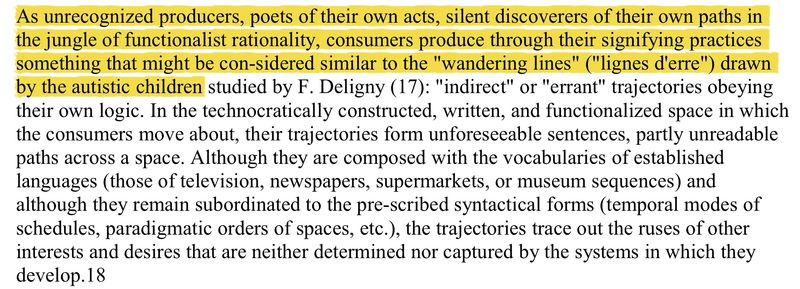 (Rendall translating de Certeau, Practice, xviii)
(Rendall translating de Certeau, Practice, xviii)
I am not explicitly taking up the power dynamics de Certeau so beautifully explores in this work. Yet, his consistent challenge of the production/consumption binary without erasing the role of the structures or the participation of the ‘consumer’ reinforces our approach here of book as interface that provokes production. De Certeau also helpfully reminds me that book as interface does not necessarily erase the operations of book as container. The container attributes of book remain as a part of the material structures that constitute the potential productive space of the interface.
De Certeau uses reading as one of his examples of “everyday practices that produce without capitalizing” (Rendall translating de Certeau, Practice, xx). He notes the often assumed writing-reading binary as a specific example of the production-consumption binary, but articulates a notion of reading that can not be reduced to this dichotomy. Reading is a “silent production” (xxi), “a play of spaces” (xxi), “an ‘art’ which is anything but passive” (xxii), and most poingnantly, reading “transforms another person’s property into a space borrowed for a mo-ment by a transient” (xxi). Reading as everyday practice is a poiesis, a making, within structured constraints that resists the production-consumption binary and thus offers a notion of reading as encounter that produces both the reader and the text.
probabilistic
In an essay titled ‘Entity to Event: From Literal, Mechanistic Materiality to Probabilistic Materiality,’ Drucker expounds in much more detail her use of the term probabilistic as it relates to reading interfaces.
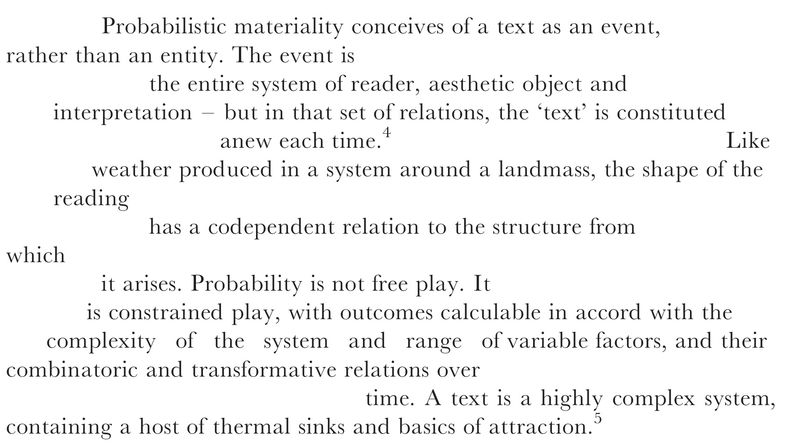 (Drucker, ‘Entity to Event,’ 8)
(Drucker, ‘Entity to Event,’ 8)
We can tell even in ‘Interface Theory,’ that probabilistic is an alternative to mechanistic for Drucker in her analysis of the shortcomings of interface design as driven by the software development world (Drucker, ‘Interface Theory,’ 10). Here, in this passage from ‘Entity to Event,’ with its strange alignment, we can see her ability to both show and tell the role of materiality in the reading event. This claim of event rather than entity is parallel to my suggestion that book as interface is an encounter not just a container. The basic distinction between the mechanistic and the probabilistic for Drucker is that the former attempts to present a user with an entity to consume, while the latter presents the reader with a set of possibilities that condition at reading event that will inevitably be new every time.
 (Drucker, ‘Entity to Event,’ 14)
(Drucker, ‘Entity to Event,’ 14)
This points back, in a way, to the interruptive emergence we found in Soja’s notion of thirdspace and begs a further discussion about the role of complexity theory in Drucker’s concept of interface as event.
MORE ON COMPLEXITY, PROBABILITY, AND EMERGENCE.
Rather than simply presenting a user with an entity to consume, a probabilistic materiality of interface provokes production of both text and subject in the practice of reading. Let’s look more closely at the provocation of interface, which Drucker suggests is related to the cues and clues an interface offers for the performance of a text.
provoke
I love that Drucker celebrates the provocation of reading interfaces. A codex doesn’t simply lay passive on the shelf waiting to be opened and penetrated by the reader. The materiality of the book as interface participates in and even provokes a reading event. A page from a book in Amazon reader on my iPhone, which gives me as reader all kinds of power over the page, provokes a possibility set of reading tactics, even if not entirely determinative. Book as container just waits to be consumed, book as interface provokes encounter.
This provocation reminds us that interface is an active participant as structured environment in the production of meaning that is a reading event. One way to talk about the material dispositions of an interface is through affordances. Affordances are the set of real or perceived use possibilities offered by the material design of an interface in relationship to a particular user and context. The history of the term affordance is well established, beginning with James J. Gibson in the field of psychology and brought into the realm of HCI through Donald Norman’s book The Psychology of Everyday Things, which is charmingly known as POET.
See McGrenere and Ho, ’Affordances: Clarifying and Evolving a Concept,’ 1, for a brief history of the use of the term.
 (Norman, POET, 9)
(Norman, POET, 9)
This is what Norman offers as a definition of affordance. As McGrenere and Ho demonstrate, there is a lot of debate and extension around this definition. For our purposes, the importance of affordance is that there are material properties of an interface that present a possibility set of uses to a reader. This is different than affordances ‘determining’ the reading event or even the total set of possibilities for use. Here, I prefer to reach back to Gibson’s use of affordance in that he defines affordance realtionally. MORE…
Affordances as a set of possibilities in a given field remind me of Pierre Bourdieu’s notion of habitus. Contrast the set of structures/possibilities in interface affordance to the structuring structures that present a subject with a possibility set in a field. Neither are determinative for practice, but they do shape the space significantly. MORE…
pathways
-
pathways project Thankfully, we already have some compelling and instructive examples of people trying to design book as interface in our emerging media age. John Miles Foley’s pathways project offers an amazing example of exploring book as interface that provokes probabilistic production in the reading process. The Pathways Project explores the analogies between oral tradition (oAgora) and the internet (eAgora) in their shared challenge to the operations of print media (tAgora). The Pathways Project is full of insights and limits, both of which can provide useful launching places for our experiments here with book as interface.
-
future of academic book In her essay, Drucker makes some hints toward what we might find in emerging scholarly interpretive reading interfaces. There is a movement afoot that is gently and gradually trying to take seriously this call to imagine the academic book as interface in our emerging media landscape. The Future of the Academic Book project began as a collaborative project…Though I have had a hard time seeing how the FOAB project has interrupted the established dispositions of print and codex to allow the possibilities of emerging technologies, the community of discourse that has fostered this movement has most definitely demonstrated a desire for and commitment to a constructivist and collaborative process. Their patience and respect for tradition could create the necessary space for translation of the deeply ingrained material sensibilities embedded in the culture of the academic book. I hope to incorporate the innovative spirit and the patient wisdom of both Drucker and the FOAB project as we push toward imagining bible as interface.
We now have a model of book as interface that provokes probabilistic production in the practice of reading and some examples of design in this direction. In the next chapter, I will advocate for one particular affordance in our design of bible as interface, anarchy.